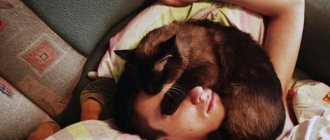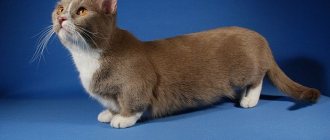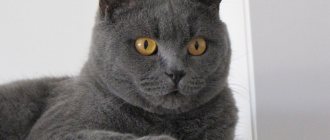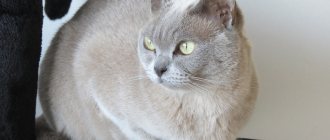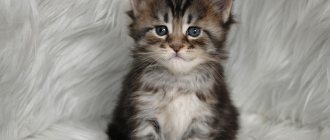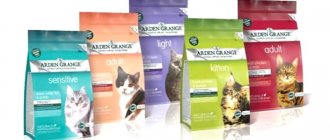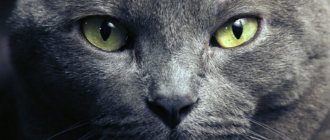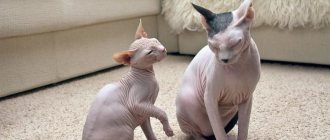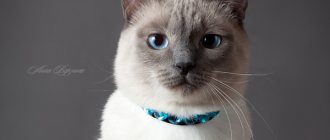Kittens can be different: by color, age and origin, purebred and outbred, with and without documents. Of course, all this affects the cost. The price can be completely ridiculous and prohibitively high.
On average, the price varies from 5 to 45 thousand rubles.
Babies of popular and rare breeds are more expensive, but even within this niche prices vary significantly (from several hundred to tens of thousands of rubles). A pet from abroad can be even more expensive.
So how much does a kitten cost: a Scottish Fold or a British one, for example? What does this depend on, and how can you reduce your costs by purchasing a purebred pet. We find out the pricing factors.
Possible colors of Scottish Fold cats
The presented breed is distinguished by a wide variety of colors due to the rich genetics of British Shorthair cats, thanks to which the Scottish breed was bred. These pets are rarely single-colored. Often there are 2, and sometimes 3 shades in a cat’s color. The most common colors are the following:
- Solid, that is, solid. It can be black, blue, purple or variations thereof. In cats with this coloration, the entire body is colored evenly in one tone.
- Torti, or tortoiseshell. This color consists of 2 primary colors – black and red. The proportions are individual for each animal.
- Smoke (smoky). This variety is distinguished by an interesting feature of the uneven distribution of the shade of each hair. As a rule, the undercoat is light, while the tips of the hairs are quite dark.
- Tabby. This color is the second most popular among fold-eared cats. The animal has spots and stripes. The latter are much darker than the fur. In addition, the letter “M” on the forehead, which is distinguished by stripes of dark fur, is considered a mandatory feature.
- Bicolor. With this color, two shades stand out: white and any other dark. The latter covers the tail, back, and upper part of the head of a fold-eared kitten, but the tips of the paws, belly and chin remain white.
- Color point. This color is perhaps the most beautiful among breeders. With this color, the ears, tips of the paws and the mask on the pet’s face are dark, while the whole body is light.
- Calico. This color is the rarest and most prized, essentially combining bicolor and tortoiseshell. The lower part of the body is painted white, the upper part is tortoiseshell. Patchwork tortoiseshell is what this color is often called. It is found exclusively in cats. The Scottish cat of the indicated color is a carrier of genes of different shades, which is why it is highly valued for the reproduction of the litter.
Nutrition
Most cats of this breed are not prone to obesity and do not overeat. You can feed your Scotsman both ready-made food and natural food; only human food from the table is not suitable for a cat. Your pet must be accustomed to a certain diet right away, from childhood.
Feeding your pet with industrial food is the best solution for working, very busy people. Manufacturers of premium food take into account the various characteristics of cats, including age, so each pet can be given suitable nutrition, taking into account its individuality. The main thing is that the food is of high quality, from a reputable brand. They include not only the nutrients the animal needs, properly balanced, but also vitamins, minerals and other compounds. That is, they provide a complete diet, and the owner does not have any worries.
If the owners have opted for natural food, they will have to prepare food for their pet separately. The diet of an adult animal should mainly consist of protein foods, since cats are carnivores, their gastrointestinal tract is adapted to digesting soft fibers of meat.
The basis of nutrition should be lean meat and poultry. Meat by-products, porridge, and vegetables are also allowed; cottage cheese, fermented baked milk, and yogurt are required.
There is no need to give milk: after the kitten reaches the age of breastfeeding, it does not produce enough enzymes to digest whole food. It is sometimes possible to pamper your cat with fish, especially if she loves it, but this is often not recommended. In cats with a fish diet, the risk of developing urolithiasis and cholelithiasis greatly increases.
The character of a fold cat: what you need to know
Scottish Fold cats are considered to be cats that are very attached to their owner. They must be constantly close to the owner, they can constantly follow him so as not to miss the owner’s important matters. A fold-eared cat adapts quite quickly to new things, be it the appearance of a baby in the house, a move, or unexpected noisy fun.
These cats are quite calm animals. They can get along well with children and other pets. They treat family members with respect and will not meow in vain.
Kittens love to frolic and make noise. However, by about 3 years of age, playfulness disappears, and the lop-eared pet turns into a calm friend. The cat has a measured lifestyle, preferring a quiet rest in its favorite place to noisy fun.
Fold cats love to purr and snore on their owner's lap, thus expressing their love. You will never feel lonely next to such a wonderful pet. In turn, the owner should provide his beloved family member with quality care, and then the animal will reward his older friend with affection and tenderness.
Mr. Cat recommends: character traits
Cats of this breed have an amazing, gentle and peaceful character in the cat family, even among domestic cats. They become very attached to a person, while most of their brothers still rather experience tender feelings for a specific place. They need manifestations of love and care, love affection and sitting on laps.
Many Highland Folds have one peculiarity: when they are interested or surprised by something, they sit down on their hind legs, reminiscent of a meerkat.
If there are children or other animals in the house, even those that naturally cause a hunting stance in the cat, you don’t have to worry: Highland Folds get along well with all representatives of the fauna, including dogs, rodents and birds. As a rule, they treat strangers without fear and wariness, they willingly go into their arms and allow themselves to be stroked. They generally like people's attention.
If people are busy, then the Highland Fold will not persistently pester, demand games or other forms of attention. They will perfectly find something to do on their own. At the same time, cats of this breed are very careful; as a rule, they do not pay attention to furniture, curtains and other interior items in order to sharpen their claws or otherwise damage them.
Kittens of this breed, like other kids, love to play and run, so the pet needs to prepare cat entertainment and toys in advance. They love to play with people, but you can safely leave them with children: they are absolutely not aggressive, they will not scratch or bite.
As cats mature, they become calmer, even sedate. If the owners are constantly at work, this does not cause any discomfort to the Highland Fold; he easily remains alone, but is very happy when people come. However, for this cat, schedule, order, and feeding at certain times are extremely important. She really doesn’t like the lack of orderliness, especially if there are interruptions in meals.
Appearance
Body: round, medium size; well filled, even from shoulders to hips.
Head: round, chin and jaws well developed. The cheeks are round (in cats they are more developed), with clearly defined whisker pads. The neck is short.
Ears: the smaller and more strongly folded, the more promising the pet is, and the rounder its head appears. There are also Scottish folds with straight ears, or “straights”.
Eyes: Large, wide open, round in shape, set wide apart and separated by a wide bridge of the nose. The color must match the coat.
Nose: Short and slightly convex. Nice soft curve in profile with a designated stop.
Tail: can be of medium length or long, tapering at the end, and must be proportional to the body.
Coat: short-haired cats have soft, thick and dense coat, with a well-defined undercoat; in long-haired cats, it is silky, elongated at the collar and pants, and not prone to matting.
Color: the color range is very diverse, all possible color combinations are allowed, and all colors of Scottish Folds are recognized as the standard.
Kittens
Scottish Fold kittens are very playful and tame, they love to spend time with children, but may not tolerate too noisy company - so if you have children, then kids who are already adapted to social communication and independence should move in with you. They are easy to train and quickly get accustomed to the toilet and scratching post, so they won’t cause much trouble.
Scottish Fold kittens are born with straight ears, and only after three to four weeks it becomes clear whether they will remain that way or “lie down.” At twelve weeks, it is possible to determine the class of a kitten - whether it will be a show "show" (only in the case of well-fitting ears, or straight-eared - but not in all felinological systems), a breeding "breed" or a domestic "pet".
Health and disease of the Scottish breed
Scottish Fold cats are considered to have fairly good health. However, the mutant gene still makes itself felt. Diseases of Scottish cats occur, mainly transmitted by inheritance.
The most common disease in Scottish Fold cats is osteochondrodystrophy. This disease is characterized by impaired development of cartilage and bone tissue. This leads to fusion of the vertebrae, incorrect positioning of the paws and improper formation of joints. All this causes pain to the animal, the pet moves little, and movements are constrained.
Due to the anatomical features of the ears, the Scottish Fold cat is susceptible to diseases of the auditory canal, such as:
- Otitis. Inflammation of the ear canal is most often a consequence of a bacterial infection. A predisposing factor is also insufficient or excessive ear hygiene.
- Tumors. A mutant gene can cause pathological cell division and the appearance of tumors.
- Otodectosis. A parasitic disease caused by the proliferation of ear mites. Causes severe itching in animals. If left untreated, it leads to otitis media, and in more advanced cases even to deafness.
- Deafness. It can act as a separate disease or as a consequence of advanced cases of the above diseases.
Scottish Fold cats are a brachycephalic breed. As is known, such animals are predisposed to eye diseases:
- Increased lacrimation. Perhaps your Scottish Fold cat's eyes are watery due to a blocked nasolacrimal duct.
- Turning of the eyelids. A common disease. Usually treated surgically.
- Eye injury. Mechanical eye damage is more common in brachycephalics.
Also, the Scottish Fold cat is predisposed to heart disease, polycystic kidney disease and metabolic diseases (ICD, diabetes mellitus).
To maintain the health of your Scottish pet, it is necessary to carry out preventive measures. Provide proper care for Scottish Fold kittens from childhood. It is mandatory to vaccinate Scottish Fold kittens according to their age. You need to make it a rule to conduct a medical examination once a year or at least once every 2 years. Undergo diagnostic tests, take tests, do an ultrasound. This will allow you not to miss hidden diseases and recognize them in the early stages.
Ear and dental care
The British Straight-eared kitten also requires careful ear hygiene and regular dental care. Such procedures involve cleaning the ears using a special cotton swab, which is moistened in a liquid purchased at a veterinary clinic.
Considering the peculiarity of the structure of the ears, a scrupulous attitude to their hygiene is required, which consists of carefully turning out the ear cartilage and cleaning the ear canal
Examination and cleaning of teeth should also become a mandatory procedure, since identifying or forming plaque on teeth at an early age will allow them to be quickly eliminated almost painlessly. Your cat's teeth should be white and her gums an even pink color. Inflammation or swelling of any type is not allowed.
By following these basic rules on how to care for a Scottish cat, you can provide your pet with a well-groomed appearance and good health.
Care and maintenance
Cats of this breed do not require special care. However, the breed is long-haired and this should definitely be taken into account.
The coat needs to be brushed regularly and the cat needs to be washed to keep it healthy and beautiful. To comb long hair, your pet must have its own comb.
Brushes with fairly sparse teeth made from natural material are best suited.
The Longhaired Scotsman should be brushed daily, and more often during the shedding period, twice a day. It's okay to miss a day, but no more. Brushing is a pleasant and useful procedure for these cats; the teeth massage the skin, thereby improving its blood supply, and the coat grows healthier, softer and silkier.
The Highland Fold should be bathed regularly, but not too often, about once every 6 months. Firstly, due to water procedures, the protective fat layer is washed off from the skin, the coat becomes dull and loses fluffiness from frequent washing, and secondly, like most domestic cats, the Scots, to put it mildly, have a cool attitude towards water. The washing procedure is stressful for them, and in order to reduce its level, you need to accustom your pet to bathing from a very early age. He will not get used to it, but there is a chance that he will tolerate the procedure a little more calmly.
Another necessary hygiene procedure is cleaning the ears. This should be done approximately once every two weeks, being careful not to damage the ears. A regular cotton swab is suitable for the procedure.
Kittens get used to the litter box quickly: it’s enough to show the litter box a few times and explain to the cat what it’s for. Highland Fold owners should carefully monitor the cleanliness of the potty, since by nature these cats are very neat and clean.
If there is a strong odor or old litter in the tray, they may well refuse to use it.
Highland Fold cats, like other domestic cats, need to have their nails trimmed and their eyes and teeth cleaned regularly. At 2 months you need to get vaccinated against viral infections. Further vaccinations are given according to the schedule. In veterinary clinics, you can ask for a special reminder or develop an individual schedule with your doctor.
How long do Scottish fold cats live?
Due to the fact that the Scottish Fold was bred by combining genes from different breeds, representatives of this breed may develop congenital diseases of the musculoskeletal system (due to the dominance of the lop-eared gene).
Other diseases may also be observed: glaucoma, entropion of the eyelids, congenital deafness and all kinds of allergic reactions. At a later age, cardiovascular pathologies may occur.
In good conditions, Scottish cats live up to 15-16 years. If any congenital pathologies occur, life expectancy can be reduced to 10-12 years.
How does the price of a Scottish Fold cat work out?
Today, when setting a price, a large number of cost factors for a Scottish kitten are taken into account. The main ones are:
Kitten class – all kittens are divided into 4 classes, depending on which the bulk of the price is determined. The following classes are distinguished:
- top show - kittens in this category are sold at the highest price possible. They are more than 3 months old, they have expert marks and are licensed to participate in European-level exhibitions. Having purchased such an animal, you can be sure that it is elite and 100% meets all exterior requirements. The cost of the most expensive Scots of this class can reach several thousand dollars;
- show class - these cats are potential winners of exhibitions, but due to their insufficient age they do not yet have expert assessments. Parents of kittens have awards at various exhibitions. Compliance with exterior requirements is as high as possible. With age, a cat can change from a fold-eared cat to a straight-eared cat, which, although rare, does happen;
- breeding class - this class includes only cats; cats do not fall into it. Such a cat can be used for breeding, but one cannot count on significant titles, since this class has deviations from the standard, which, however, are not disqualifying;
- pet class – it presents animals that are not suitable for exhibition due to deviations from the required conformation. Such a pet will also not be suitable for breeding. A fold-eared cat belonging to this category stands as low as possible, but a layman will not even notice its shortcomings. The character of the pets will not differ from the character of an elite cat. If you just need a friend with whom you do not plan to visit exhibitions and breed, then you can buy a kitten of this particular class without hesitation.
Breeding - if an elite kitten is purchased that can be used for breeding, the breeder is certainly interested in whether the future owner is ready to attend exhibitions and receive kittens from the animal. If a Scot is purchased exclusively for oneself, then there will be no right to breed him, and the price will be lower. If the kitten has a rare color, if breeding is not planned, its purchase may even be refused.
Sale with conditions - in certain cases, in the Moscow Scots Club, when purchasing a kitten for breeding, the owner is subject to the condition of transferring a certain number of kittens from the litter to the nursery from which their pet was purchased. This is necessary for the seller’s breeder’s further breeding program.
shutterstock
Exclusive colors - the more common the color of the cat, the cheaper the animal is. The main colors of Scots are blue, cream, lilac, harlequin and straight.
Eye color – this indicator is also important. Kittens with yellow and orange eyes are quite numerous and do not represent significant value in this regard. Green-eyed and blue-eyed kittens cost significantly more, since there are not many of them.
Age – reliable professional breeders will not give away a kitten earlier than 3 months, because before this age all vaccinations are given to it and its class is assessed. The cost of keeping a Scottish cat during the period of active growth is quite high.
International status of the nursery - the more titled the nursery, the more expensive the kittens are.
Availability of documents - as a rule, private breeders sell Scots without documents by advertisement, which makes it almost impossible to guarantee that the pet matches the exterior until it grows up.
History of the Scottish Fold breed
The first mention of cats with floppy ears was recorded in Chinese sources in 1796. At the end of the 19th century, fold-eared cats were brought by sailors to Europe. The origins of the Scottish Fold breed can be traced back to 1961 with the cat Susie.
The fold-eared cat lived on a Scottish farm and was her owner's favorite. In 1963, residents of a nearby farm became interested in a cat with an unusual ear position. At the first opportunity, William and Mary Ross acquired a kitten from Susie and named him Snooks.
Snooks' offspring also had babies with floppy ears. Mary decided to cross her cat with a British cat. As a result of this crossing, kittens appeared. They were more reminiscent of the fold-eared Scots, as we are used to seeing them now.
The popularity of unusual Scottish cats grew. Genetic scientists also became interested in them. They found that the cause of this altered ear is a mutated gene. During the research, it was revealed that the presence of such a gene is unsafe for the animal. In addition to deformation of the ear cartilage, the gene can cause changes in other cartilages and fusion of vertebrae. But science does not stand still, and scientists have found a solution to this problem. The secret is to choose the right male and female. However, in England to this day cats with the mutant gene are not recognized.
To obtain healthy offspring, it is allowed to cross Scottish Folds only with Scottish Straights. Or crossing with a British cat is allowed.
In 1978, the Scottish Fold breed was officially registered and was allowed to participate in exhibitions.
Breed characteristics
The head is usually round in shape, the jaw protrudes slightly forward. A distinctive feature of cats of this breed are prominent cheeks and clearly defined whisker pads. These features are very clearly visible in the photo below.
The neck is thick and short, the nose should also be short and with a slight hump.
A specific eye color is not assigned to a breed, but depends on the coat. The eyes are round.
Special attention should be paid to the paws of Scottish Fold cats - they are small and round in shape. At the same time, the hind legs are often thickened, which can interfere with the normal movement of cats and bring some inconvenience to their owners. The coat should be thick and elastic, but any specific color is not typical for these cats
The coat should be thick and elastic, but any specific color is not typical for these cats.
Conditions of detention
Scottish cats are considered one of the easiest pets to care for. They feel great both in a small apartment and in a private house. It is worth buying or making your own personal sleeping place for an animal. It is also recommended to purchase a scratching post, the length of which should correspond to the height of the Scottish cat. You should not refuse to buy a carrier to transport your pet if necessary.
The Scots are not picky when it comes to content. In order for an animal to live comfortably in a room, it must be clean and safe. This pet is extremely clean, he puts his fur in order and quickly gets used to going to the litter box.
Before bringing a small pet into your home, you need to complete the following steps.
- Remove unnecessary objects from the kitten's access area. For example, wires, breakable and sharp objects.
- Buy food and water dishes for the animal. The best option would be heavy metal or ceramic cookware.
- Place the tray and fill it with filler. Kittens should buy a container with low sides, and as they grow older, change it to a higher model.
- Prepare a place to rest - this can be a sunbed or a blanket folded several times.
- Buy food, toys, scratching post.
Grooming
Scottish cats can be shorthaired or semi-longhaired. With cats that have short hair, there is little hassle. Their fur is brushed weekly using a special mitten or a brush with natural bristles. Semi-long-haired representatives of the breed should purchase a comb that has Teflon-coated teeth. Animals should be taught to comb from a young age.
Animals kept in the house are bathed monthly. Scots usually react well to water, but they should only wash their coat if it gets dirty. For this procedure you need to buy a special shampoo for cats. When bathing your pet, you need to make sure that water does not get into his ears. After washing, the cats are dried and sent to a warm place where there is no draft.
For water procedures, preference is given to colorless and odorless shampoos that do not contain harmful chemical ingredients and allergens. Scottish cats that participate in exhibitions are bathed depending on the color of their coat. Dark animals need to be washed a week before the event, and light animals - 5 days.
Haircuts for Scottish cats are unpleasant, but common procedures. Pets are given haircuts and hairstyles for the same purpose as other animals. This procedure can be carried out only if tangles have formed, as well as after applying medications or to remove dirt.
Nail care
Domestic cats need their nails trimmed. This process is quite simple and does not cause discomfort to the animal. You need to put Scottish on your lap and, taking his paw in your hands, press on the pads. Once your pet has released its claws, they can be trimmed. In this process, the main thing is not to damage the living body of the claw. Claws should be trimmed carefully, once every 2-3 weeks.
Eye and ear hygiene
The eyes and ears of Scottish cats need regular examination. These animals usually have clean ears, but when plaque appears in them, the contamination is removed with a cotton swab. When cleaning your ears, you can also use a special lotion.
The special structure of the skull of the Scottish breed of cats causes the narrowing of their nasolacrimal ducts. For this reason, your pet may experience slight discharge from the eyes. In this case, the eyes need to be cleaned with a cotton pad or chlorhexidine wipe.
Dental care
To keep the pet's teeth in good condition, the owner can buy him a special toy - an edible chewing stick. Alternatively, you can use a toothbrush and toothpaste for cats. A Scottish cat's teeth should be brushed 1 or 2 times a week. Scottish dogs do not like this process, so it is better to accustom them to this from an early age.
Kitten care
Scottish kittens do not require special care. They can be fed dry food, but of good quality. Kittens should not be brushed unless there is a reason for it. Babies with long hair should be gradually accustomed to brushing, carrying out the procedure twice a month. Little Scottish cats need to be bathed only if they are very dirty in the mud.
Kittens need to have their nails trimmed from an early age so that they get used to this procedure. You don't need to clean your ears, but if they smell bad, that's a reason to go to the vet. Watery eyes should be wiped once every 7 days with a cotton pad soaked in chlorhexidine.
Breed characteristics
The head is usually round in shape, the jaw protrudes slightly forward. A distinctive feature of cats of this breed are prominent cheeks and clearly defined whisker pads. These features are very clearly visible in the photo below.
The neck is thick and short, the nose should also be short and with a slight hump.
A specific eye color is not assigned to a breed, but depends on the coat. The eyes are round.
Special attention should be paid to the paws of Scottish Fold cats - they are small and round in shape. At the same time, the hind legs are often thickened, which can interfere with the normal movement of cats and bring some inconvenience to their owners.
The coat should be thick and elastic, but any specific color is not typical for these cats.
What to do before the appearance of the Scottish fold?
Scottish Folds are usually ready for independent life at 2-3 months of life, it is at this time that they are weaned from their mother, but before you get this kitten, you need to carefully prepare everything.
- First of all, you should purchase dishes from which the baby will eat and drink. It is best to give preference to bowls made of stainless steel or porcelain; a container made of food-grade plastic may also be suitable. Additionally, you will need to buy toys, a house and a tray with filling. Since the kitten will need to be shown to the veterinarian periodically, it is necessary to buy a spacious carrier; it will also come in handy during trips to the country.
- The next stage of preparation will be drawing up a daily routine and selecting a balanced diet. At first, it is not recommended to give dry food to the little handsome guy.
- The final step will be preparing the site for the house. It should be protected from drafts and not noisy, so that the pet can rest comfortably (Scottish Folds are large sleepyheads). When the animal gets used to its new habitat, it will gradually begin to explore the entire space of the room. During this period, the baby needs to be given maximum attention and given affection.
Cost and where to buy
The price range for Scottish fold kittens is wide - from 10 to 30 thousand rubles in Moscow (data as of the end of January 2022). Scots are a fairly common breed, and ordinary people often confuse Straights with British dogs and vice versa, so data from open sources should not be considered definitive.
Exactly how much a Scottish Fold kitten costs depends on the origin, achievements and titles of the parents, and the exhibition prospects (class) of the kitten. A show-class baby can cost over 57 thousand rubles, and due to highly specialized shortcomings, you can get an excellent Scotsman classified in the pet class for a modest 11-12 thousand rubles.
Choosing a kitten
The kitten is taken from the breeder no earlier than 2.5-3 months. By this point, he will receive immunity and primary social skills from his mother, and the first vaccinations from the owner.
You should not take the largest and most active or the smallest and calmest baby. Both of these are fraught with problems with the cat’s behavior in the future. It is better to take an active, but friendly and curious kitten, and if he chooses you, this will be a big plus.
The kitten should be clean, plump, smell nice and not have bald spots or scratches. By this age, he should already have determined the color of his eyes and the shape of his ears. Sometimes floppy ears rise with age and vice versa. The baby's fur is not yet the same as that of adult cats, but you can already understand whether the cat will be short-haired or long-haired. You can also guess with high accuracy what the color will be, but it will become completely contrasting much later.
It is important to decide in advance why exactly you are getting a cat. Any Scot can become the “master of the sofa and the heart,” but you will be able to participate in exhibitions only with a fold that perfectly matches the breed standard. Straights are healthier and are valued for breeding, since crossing folds with each other is prohibited
Straights are healthier and are valued for breeding, since crossing folds with each other is prohibited.
If you are not going to engage in breeding, then it would be better to sterilize the animal. The operations of sterilization of cats and castration of cats are carried out at the age of eight to ten months, when the body is already formed and is able to safely tolerate general anesthesia. This does not harm the pet’s health; on the contrary, it makes it calm and not subject to hormonal surges and associated risks.
If you are not averse to trying yourself as a breeder, then keep in mind that puberty in these cats begins early - the first heat can occur at the age of about six months. But it is not recommended to knit before a year. The optimal time for mating is the third or fourth heat. Scottish Fold cats remain pregnant for about two months. On average, birth occurs at 63-65 days.
Buy a Scottish Fold from reputable breeders or from a Scottish Fold nursery, as a kitten can inherit a lot of health problems from improper mating.
Nurseries
Scottish fold cats are professionally bred in almost every region and major city of Russia and the CIS. For example, Scottish nurseries:
- Ru-Star Fold (Moscow) - https://www.ru-starfold.ru;
- EridanCats (St. Petersburg) - https://mystic-cats.ru;
- UrFo (Ekaterinburg) - https://urfocat.ru;
- Landfold (Astana) - https://landfold.ru;
- Little-Kitty (Minsk) - https://little-kitty.by/.
The Scottish Fold cat is independent enough to wait for you from work without hysteria or vandalism. But when the owner of the house, he simply must sit with his pet on the couch, discuss the news and watch TV. Affectionate, sociable and unpretentious breed in everyday life. An excellent companion for those who value the peace and comfort of home. If the description of the Scottish Fold cat breed did not lead you to a final decision, then reviews will help.
Video on the topic
Scottish Fold cats: features and care
Buy a Scottish Fold kitten
Despite the fact that the fold-eared breed is relatively young, it is very popular. In this regard, you can find many nurseries and breeders breeding this breed. When buying a Scottish fold kitten, you need to be vigilant, as you can easily suffer from the activities of scammers.
How to choose a fold-eared kitten
First you need to choose where to buy. Nurseries usually offer good kittens for sale. Children have vaccinations according to age and plus a package of documents. Purchasing a Scottish kitten from breeders is not the worst option. You can find responsible breeders who take care of their pets. Some, as well as nurseries, sell vaccinated kittens.
The optimal age for selling fold kittens is considered to be at least 2, and preferably 3 months. If you are offered to take a one-month-old kitten, this is wrong. At this age, the baby still needs maternal care. Also, at the age of 1 month, it is difficult to consider any congenital abnormalities. At 2-3 months this is much easier to do.
All newborn Scottish Fold kittens have straight ears. Therefore, to purchase a fold-eared kitten, you need to wait at least 3-4 weeks.
It is worth paying attention to the mobility of kittens and their playfulness. Scottish Fold kittens usually move around the room with ease and climb on objects. It would also be correct to assess the general health of the baby. Its fur should be clean, especially near natural openings. There should be no bloating. Pay attention to the tail: it should be flexible and mobile. Pay attention to whether the eyes of the Scottish Fold kitten you notice are watery.
Scottish kitten cost
The average price of a Scottish Fold kitten varies from 5,000 to 35,000 rubles ($100-500). The cost depends on the pedigree, whether the parents are titled or not, and how pronounced the breed characteristics are. A Scottish Fold kitten for exhibitions or breeding will cost more than a pet for pets.
Scottish catteries
Catteries for Scottish Fold or Scottish Fold kittens can be found in all major cities of the CIS countries.
Moscow
- www.cats-style.ru
- allegiancelove.ru
- Scottish.rf
Saint Petersburg
- alcasarcat.ru
- www.s-fold.ru
- lifejoycat.ru
Kyiv
- bastet.in.ua
Vitebsk
- real-cats.ru
Minsk
- ledy-koshka.com
Newborn care and nutrition of a Scottish kitten
Sometimes the baby is separated from the mother very early (for example, due to the cat’s illness), and then a person must take on all the care of the newborn kitten
The owner should pay special attention to the feeding and hygiene of the pet.
Nutrition
To feed a small cat you will need a bottle with a nipple, a pipette, a medical syringe, a measuring spoon and a container for preparing the mixture.
Algorithm for feeding a newborn Scottish kitten:
- From the first days, babies eat every 1.5-2 hours - this schedule must be strictly followed.
- You can feed a kitten only with special formulas for newborns or a cat's milk substitute.
- The mixture is given only from a soft nipple, so as not to damage the mucous membrane in the oral cavity.
- In the middle of a meal, you need to raise the kitten in an upright position - he will burp air and later continue to eat.
- After eating, you should massage your tummy clockwise.
After the first week, feeding is carried out every 3 hours, by the 15th day this interval is increased by another half hour, and by a month the kittens are already eating 6 times a day.
When the baby turns 1 month old, liquid porridge and other suitable ready-made mixtures are added to the diet.
Defecation and urination
Under normal conditions, the mother cat is responsible for stimulating the act of defecation and urination, but in her absence, the owner will have to do this independently after each feeding:
- The kitten is placed on the palm, with its tail turned towards you.
- Massage the anal area with a warm, damp cloth.
- At the same time, use your thumb to stroke the pet at the base of its tail.
- The movements continue until the process is completely completed.
- After the kitten goes to the toilet, remove all discharge with a clean damp cloth.
Any deviation from the norm must be immediately reported to the veterinarian and further act according to his recommendations.
It is believed that Scottish Fold cats are loyal to all family members, get along well with other pets, are well trained and have good health. All these signs are laid down in childhood and later help to raise an obedient and clean pet. Owners only need to follow the recommendations of specialists on the care and feeding of the Scottish Fold cat and there will be no problems with the pet in the future.
I like2I don't like
Standards
One of the most popular breeds appeared in the 60s of the last century in Scotland. After much controversy, Australians were the first to differentiate straight-eared and fold-eared cats from the British breed and set standards for their appearance.
Do you know why cats love valerian?
You can learn about sterilization and castration of cats and female cats from this material.
Scottish straights (straight ears)
- Torso. The animal is of medium size, muscular, rounded body contours. The paws are short and strong, the toes are well compressed. The tail is usually long or medium (to the center of the shoulder blade), mobile. Males are noticeably larger than cats.
- Head. The Straight's skull is convex, its muzzle and cheeks are round. Boys have especially full cheeks. Strong, moderately protruding chin, medium-length nose. The neck is short: the cat’s seemingly thick cheeks immediately turn into the neck.
- Ears. The “locators” of the Scottish straight-eared kitten, although small, are impressive: widened at the base, set high and quite wide, the tips pointed and spread to the sides, the outer surface of the ear is lowered almost parallel to the head.
- Eyes. Probably, it was the straight that we saw in the cartoon “Shrek” - the childish expression of large round eyes captivates in an instant. The color is in harmony with the color.
- Nose. A short nose with a smooth back and a moderate profile play into the hands of the cat’s touching pug.
- Wool. The fur coat of a straight kitten is thin, but dense and plush. The length is medium, tightly covering the body.
- Deviations. It is no secret that if the mating is incorrect or there are deviations in the genes of the parents, the kitten may have defects in appearance that prevent both participation in the exhibition and a normal lifestyle. In Scottish Straights this is often a too short and stiff tail, with a hook at the end, heavy movements, arched back, loose ears, incorrectly placed limbs and creaking in the joints.
Scottish Folds (loose-eared)
- Torso. Contrary to beliefs, folds are distinguished from straights not only by the shape of their ears. The body of a fold cat is medium to large in size, muscular, with a powerful neck. The paws are low and thick. The tail is often short, thick, with a round tip.
- Head. The profile of the Fold is impressive - wide nose, large whisker pads, full cheeks, short muzzle, strong chin and wide round head.
- Ears. Very small, forward-curved ears give the breed a special charm. They favorably emphasize the roundness of the head, pressing well against the skull.
- Eyes. The look of a fold-eared kitten is touching. Large eyes are widely spaced, very often slanted, which, however, touches even more.
- Nose. This part of the fold's muzzle is similar to that of the straight, but often the nose is slightly wider and shorter.
- Wool. The fold-eared breed has thick, short, non-adherent hair; the range of colors, like the straight-eared ones, is very wide.
- Deviations. The most common defects in the appearance of Folds are any deviations of the spine and tail, irregular ear shape and number of toes.
How to keep a chinchilla at home. Description of all features of care and maintenance.
How to properly care for a pregnant cat: https://kotovasia.net/...ojj.html
History of the breed
The breed standard was officially registered in 1993 and is today recognized by most influential organizations. The history of selection of fold-eared long-haired cats began much earlier, in the 60s of the 20th century.
One day, the most ordinary cat gave birth to offspring, in which one of the cats turned out to have funny, floppy ears and long white hair. This happened in an area of Scotland called the Highlands, which gave the name to the breed.
At first, lop ears were considered a sign of marriage, but then such cats began to be specially bred.
It is believed that the gene for folding ears was inherited from Scottish cats from Persian ancestors. The fact is that Persians were crossed with the British in order to improve and consolidate the breed characteristics of the latter. British cats, in turn, were involved in the breeding of the Scottish Fold, the “big brother” of the Highland Fold.
Fold cat: characteristic features
The head of this cat is predominantly round in shape with a slightly protruding jaw. A characteristic feature of the Scottish Fold breed (also called Scottish Fold) is prominent cheeks and pronounced whisker pads.
These cats have a short, thick neck, and the nose is also short, with a slight hump. A specific eye color is not assigned to fold-eared cats, since this is influenced by color. These cute animals have round eyes.
It’s worth mentioning the paws of a fold-eared cat. The limbs have a small round shape. Thus, the hind legs are often thickened, which sometimes creates an obstacle to normal movement and brings minor discomfort to the owners.
What breed are you, cat?
As an example, consider one of the most popular breeds in recent years - the Scottish Fold. The breed is stable, predictable, and quite simple to breed:
- Most cats are quite physically healthy and live a long time;
- Genetic and hereditary diseases are rare;
- Born babies survive and develop safely.
That is, from the point of view of breeding work and the costs of growing and maintaining, this breed is problem-free - the price will not increase due to natural losses or rarity.
The main attractive factor for those who want to buy a Scottish Fold cat is its appearance. A sweet little face in combination with hanging ears, tightly pressed to the head, forces even the most persistent observers to go into “mi-mi-mi” mode.
ON A NOTE! The Scottish Fold cat is not born with fold ears. The intrabreed type will be determined only a few weeks after birth. And all the babies in the breed are born with the most ordinary ears.
Caring for a Scottish Fold cat
Fold-eared cats and cats do not require too much care. The main requirement is a clean environment and plenty of balanced food.
Owners of Scottish cats often have understandable questions about caring for their pet’s unusual ears. But here, too, everything is extremely simple: the ears must be wiped with a special cleaning solution, which can be purchased at any veterinary pharmacy or pet store, or with boiled water and cotton swabs.
To facilitate shedding, experts advise brushing your pet with a special cat brush with straight, hard teeth. For short-haired dogs, it is enough to brush them once a week, for long-haired dogs - twice. Even despite the presence of a scratching post, it is still better to trim the claws of a fold-eared cat approximately once every three weeks or month. It is also recommended to rub your eyes and brush your teeth with a cotton swab.
The cat must be taught all hygiene procedures from early childhood. It is likely that the kitten will resist at first, but if you repeat the process regularly, he will get used to it, and the hostility will soon be replaced by pleasure. This especially applies to combing.
Owners of Scottish Fold cats must remember the basic rule when breeding them: at least one animal in a pair must be straight-eared, otherwise it will not be possible to avoid health problems in the offspring. In other words, only a straight-eared cat is suitable for a fold-eared cat.
